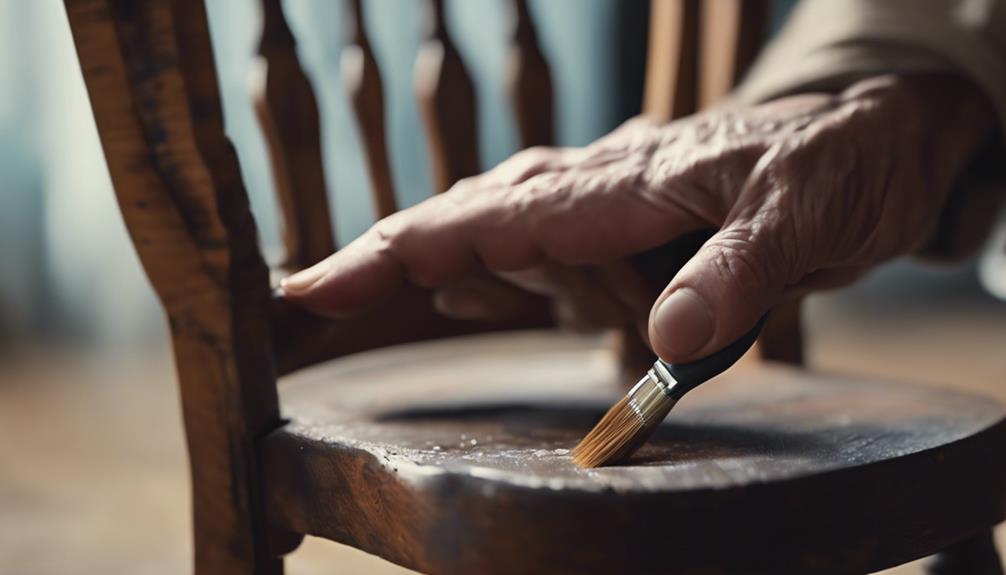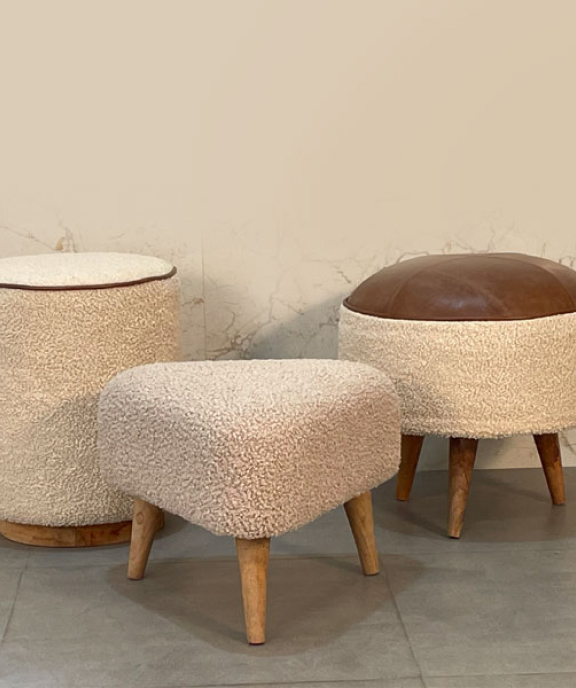When restoring antique wood furniture, consider the desired finish, level of protection, flat or satin varnish, semi-gloss, or high-gloss options, and compatibility with the wood type.
Ensure the sheen complements the piece's era and style, and protect it based on exposure and wear. Choose between matte or soft sheen, and balance the gloss level for your preferred look.
Always prepare the surface thoroughly, match the varnish to the wood type, and consider maintenance ease. Following these steps will ensure your antique furniture is restored and protected effectively.
Consider the Desired Finish
When choosing varnish for antique wood furniture, it's essential to determine the desired level of shine for the finish. Consider the sheen level that would best complement the piece, such as matte, satin, semi-gloss, or high-gloss.
Matching the era of the furniture is also important. For example, a high-gloss finish may not be suitable for a Queen Anne piece, while a matte finish may not be appropriate for an Art Deco item.
Evaluate Level of Protection Needed
To determine the appropriate level of protection needed for antique wood furniture, consider the furniture's intended use and exposure to elements like sunlight, moisture, and daily wear.
When evaluating the durability required for varnishing antique wood furniture, assess the level of wear and tear the piece is likely to endure. Key points to consider include examining the amount of direct sunlight or moisture the furniture will be exposed to, determining if the piece is in a high-traffic area that may need a stronger varnish, considering the climate and conditions where the furniture will be placed, anticipating potential damage such as scratches, stains, or fading, and selecting a varnish that aligns with maintenance capabilities and long-term preservation goals.
Choose Flat or Satin Varnish
Choosing between flat or satin varnish for antique wood furniture is crucial for enhancing the overall look and protection of the piece.
Flat varnish provides a matte finish, ideal for a natural and subtle appearance, minimizing light reflection and imperfections.
Satin varnish offers a soft sheen, balancing between matte and glossy finishes, adding a gentle glow and depth to the wood.
Both types of varnishes can enhance the beauty of antique wood furniture while ensuring protection and durability.
Proper surface preparation is essential when applying varnish to achieve a smooth and even finish.
Consider the drying time and follow maintenance tips to preserve the varnish and the wood's integrity over time.
Opt for Semi-Gloss or High-Gloss
When choosing between semi-gloss and high-gloss varnish options for antique wood furniture, consider the desired level of shine and the overall aesthetic. Both options offer unique benefits that can enhance the appearance of your restored pieces:
- Determine shine preference: Semi-gloss provides a subtle sheen, while high-gloss offers a high shine.
- Consider aesthetic appeal: The gloss level should complement the furniture's style and design.
- Reflective finish: High-gloss varnish creates a reflective surface, adding a polished and luxurious look to the wood.
- Dramatic effect: High-gloss varnish can make your antique wood furniture stand out in any room.
- Balanced sheen: Semi-gloss is a popular choice for those seeking a balance between dull and overly shiny finishes.
Check Compatibility With Wood Type
When selecting varnish for antique wood furniture, it's crucial to ensure compatibility with the specific wood type used. Porous woods like oak or mahogany benefit from oil-based varnishes. Water-based varnishes are suitable for hardwoods such as cherry or maple, offering clarity and resistance to yellowing.
Exotic woods like teak or rosewood may require special varnishes to enhance natural beauty and provide protection against moisture and UV rays. Consider the varnish options available for different wood types and choose the appropriate sheen for the desired finish.
Consulting with a professional or conducting research can help confirm the compatibility of the varnish with the specific wood type of the antique furniture being restored.
Ensure Compatibility With Previous Finishes
To ensure compatibility with previous finishes on antique wood furniture, inspect the existing finish to determine its type. Select a varnish known to work well with the current finish. Consider conducting a compatibility test in a discreet area to evaluate the interaction between the varnish and the old finish.
Follow recommended application techniques for a seamless finish that blends with the antique furniture. Prioritize varnish durability and explore maintenance tips to extend the life of the restored piece.
Look for UV Protection
Selecting a varnish with UV protection is essential to safeguard antique wood furniture from fading and damage caused by sunlight exposure. UV protection varnishes contain inhibitors that shield the wood from harmful ultraviolet rays, preserving its original color and finish by blocking the UV rays that cause discoloration.
These varnishes ensure the longevity and preservation of the wood's beauty, helping it retain its original charm and value over time. When choosing a varnish with UV protection, consider factors such as application techniques, drying time, weather resistance, and maintenance requirements. Proper application methods will maximize the varnish's UV protection capabilities.
Additionally, quick drying times can expedite the restoration process. Opting for a varnish with high weather resistance reduces the need for frequent maintenance, ensuring the wood furniture remains protected from sunlight exposure for an extended period.
Prevent Fading and Yellowing
To prevent fading and yellowing of antique wood furniture, it's essential to use a varnish with anti-yellowing properties. When choosing a varnish for restoration, consider the following factors:
- Opt for a varnish that explicitly mentions color preservation to maintain the wood's original hues.
- Select a matte or satin finish varnish to reduce yellowing and preserve the antique piece's aesthetic.
- Look for varnishes with UV protection to shield the wood from sun exposure and prevent fading.
- Choose a varnish specifically designed for antique wood restoration to ensure long-lasting protection and optimal results.
- Before applying the varnish, conduct a compatibility test on a small area to check for potential yellowing or discoloration issues.
Enhance Beauty of Antique Piece
When enhancing the beauty of antique wood furniture, opt for a high gloss varnish to bring out the natural richness of the wood grain. This varnish adds depth and enhances the details of the piece, highlighting its beauty.
Choosing a varnish with a tint or colorant can accentuate the intricate details and unique characteristics of the wood, creating a customized look that preserves the piece's authenticity.
For a more subtle sheen, consider varnishes with a matte or satin finish to enhance the overall appearance of the antique while providing protection.
Selecting a varnish that highlights the natural beauty and enhances the details of the antique wood furniture ensures its unique features are showcased and preserved for generations.
Provide Long-Lasting Protection
For long-lasting protection of antique wood furniture, it is important to choose a varnish that offers various qualities. Look for a varnish with UV resistance, as this will help prevent fading and discoloration. Opt for high durability to ensure the varnish can withstand wear and tear over time. Additionally, select a varnish with moisture resistance to protect against humidity and spills. It is also advisable to consider heat resistance to prevent damage from hot objects. Finally, choose a varnish with chemical resistance to safeguard against household cleaners and other substances.
Selecting a varnish that encompasses all these features will provide comprehensive protection for your antique wood furniture.
Frequently Asked Questions
What Is the Best Finish for Antique Furniture?
When choosing a finish for antique furniture, consider the desired look and level of protection needed. Shellac varnish enhances wood beauty with an amber hue, while polyurethane offers strong protection. Testing different finishes on a small area can help determine the best option for your piece.
How Do I Choose the Right Varnish?
Quality varnish selection considers durability, UV protection, and low VOC content. Matching sheen levels and testing compatibility are crucial. Choosing the right varnish ensures a smooth restoration and long-lasting finish for antique wood furniture.
Should You Varnish Antique Furniture?
Applying varnish to antique furniture is recommended as it provides protection, enhances aesthetics, and extends the furniture's lifespan. Varnish helps to highlight the unique characteristics of the wood, improve its overall look, and preserve its originality. While varnish offers durability, it serves a different purpose compared to wax in terms of finish and safeguarding the furniture.
What Is the Best Polish to Use on Antique Furniture?
Beeswax polish is recommended for antique furniture as it nourishes the wood. Shellac polish provides a warm glow while paste wax is versatile for different woods. Opt for silicone-free polish to prevent damage, and choose based on the wood type and desired finish.



